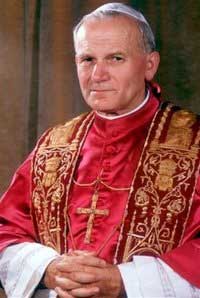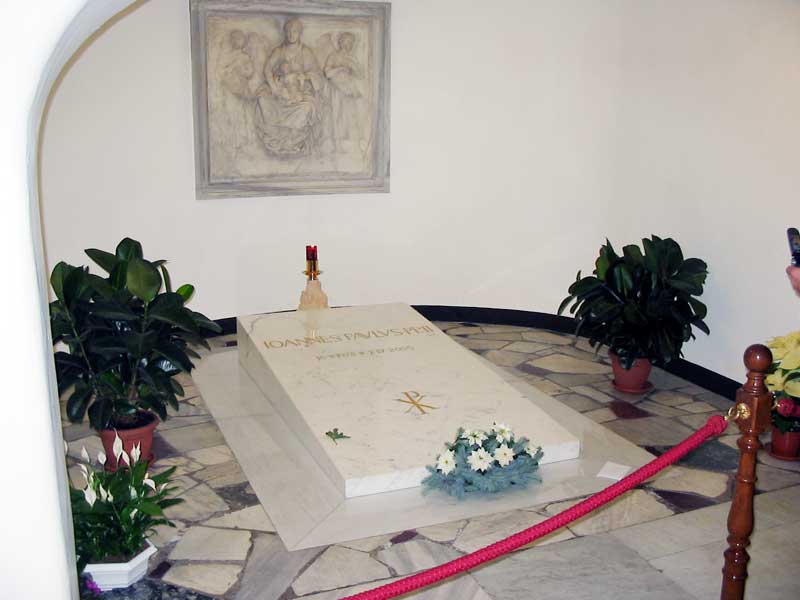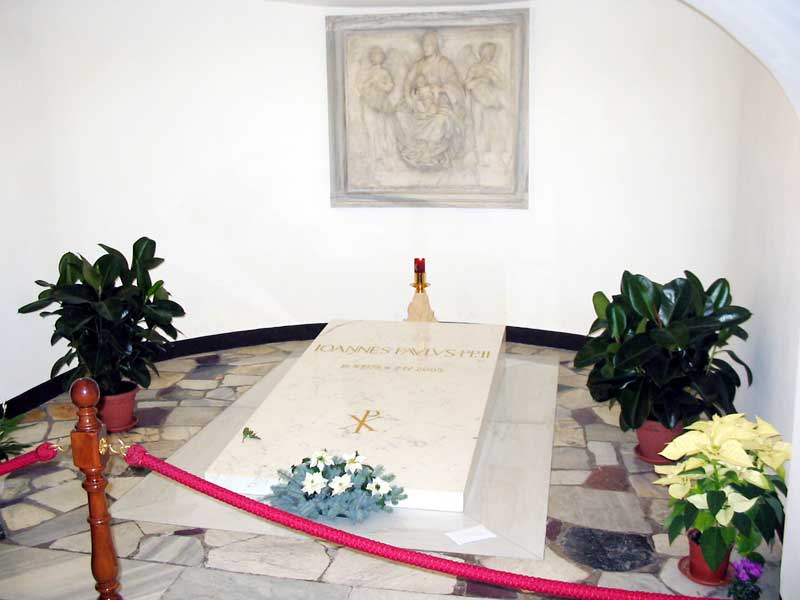


Pope John Paul II (Latin: Ioannes Paulus PP. II ), born Karol
Józef Wojtyła [1] (May 18, 1920 – April 2, 2005) reigned as pope of the
Catholic Church for almost 27 years, from 16 October 1978 until his death,
making his the third-longest pontificate. On 13 May 2005, Pope Benedict XVI,
John Paul II's successor, waived the five year waiting period for a cause
for beatification to be opened. The official process for beatification began
in the Diocese of Rome on June 28, 2005. [2]
He was the first non-Italian pope since the 16th century. His early reign
was marked by his opposition to Communism, and he is often credited as one
of the forces which brought about the fall of the Soviet Union.
In other domains, his concern for the poor, the weak and those who suffer,
and his stances on warfare, violence, capital punishment, evolution, world
debt forgiveness combined with his willingness to visit Socialist nations,
and his strong relationships with leaders of non Catholic Churches and non
Christian faiths were considered by some to be proof that he was "liberal."
His affirmation of the long-standing Christian doctrine that abortion,
homosexual sex, and contraception are immoral, his continuing the tradition
of ordaining only men to the priesthood, teaching that divorced persons
could not remarry without a declaration of nullity, that valid sacramental
marriage exists between one man and one woman, emphasizing the benefits of
retaining the discipline of mandatory priestly celibacy, and his opposition
to secularism are cited by some as proof that he was "conservative."
During his reign, the pope travelled extensively, visiting over 100
countries, more than any of his predecessors. He canonized more people than
all popes before him put together. He was Pope during a period in which
Catholicism's influence declined in developed countries but expanded in the
Third World.
Pope John Paul II was extremely popular worldwide, attracting the largest
crowds in history (at times attracting crowds of over one million people in
a single venue [over four million people at the World Youth Day in Manila),
and being respected by many even outside of the Catholic Church, despite
strident criticism from some quarters. John Paul II was fluent in numerous
languages: his native Polish, Italian, French, German, English, Spanish,
Russian, Portuguese and Latin.
In 1992, he was diagnosed as having Parkinson's disease. On 2 April 2005 at
9:37 pm Vatican Time, Pope John Paul II died while a vast crowd kept vigil
on St Peter's Square. Millions of people flocked to Rome to pay their
respects to the body and for his funeral. The last years of his reign had
been marked by his fight against the various diseases ailing him, provoking
some concerns that he should abdicate, but in retrospect his determination
was widely seen as an exemplary display of courage.
Pope John Paul IIThe man from Poland will be remembered as the "people's
Pope." Respected around the world by both Christians and non-Christians the
reach of Pope John Paul II extended across the globe.
His papacy is remembered by his tireless ecumenical approach to accommodate
other Christian bodies as well as to forge a better understanding with the
Islamic world. At his funeral, many non-Christian faiths were represented,
including representatives from Judaism, Islam and Buddhism.
John Paul II emphasized what he called the "universal call to holiness" and
attempted to define the Catholic Church's role in the modern world. He spoke
out against ideologies and politics of communism, Marxism, feminism,
imperialism, relativism, materialism, fascism (including Nazism), racism and
unrestrained capitalism. In many ways, he fought against oppression,
secularism and poverty. Although he was on friendly terms with many Western
heads of state and leading citizens, he reserved a special opprobrium for
what he believed to be the corrosive spiritual effects of modern Western
consumerism and the concomitant widespread secular and hedonistic
orientation of Western populations.
John Paul II affirmed traditional Catholic teachings by opposing abortion,
contraception, capital punishment, embryonic stem cell research, human
cloning, euthanasia, and war. He also defended traditional teachings on
marriage and gender roles by opposing divorce, same-sex marriage and the
ordination of women. His conservative views were sometimes criticized as
regressive. John Paul II called upon followers to vote according to Catholic
teachings, and suggested that politicians who strayed be denied the
Eucharist.
John Paul II became known as the "Pilgrim Pope" for travelling greater
distances than had all his predecessors combined. According to John Paul II,
the trips symbolized bridge-building efforts (in keeping with his title as
Pontifex Maximus, literally Master Bridge-Builder) between nations and
religions, attempting to remove divisions created through history.
He beatified 1,340 people, more people than any previous pope. The Vatican
asserts he canonized more people than the combined tally of his predecessors
during the last five centuries, and from a far greater variety of
cultures.[3] Whether he had canonized more saints than all previous popes
put together, as is sometimes also claimed, is difficult to prove, as the
records of many early canonizations are incomplete, missing, or inaccurate.
However, it is known that his abolition of the office of Promotor Fidei
("Promoter of the Faith" and the origin of the term Devil's Advocate)
streamlined the process. He has been criticized by many for doing this.
Pope John Paul II died on 2 April 2005 after a long fight against
Parkinson's disease and other illnesses. Immediately after his death, many
of his followers demanded that he be elevated to sainthood as soon as
possible, shouting "Santo Subito" (meaning "Saint immediately" in Italian).
Both L'Osservatore Romano and Pope Benedict XVI, Pope John Paul II's
successor, referred to John Paul II as "Great".
John Paul II was succeeded by the Dean of the College of Cardinals, Joseph
Cardinal Ratzinger of Germany, the former head of the Congregation for the
Doctrine of the Faith who had led the Funeral Mass for John Paul II.
Biography
Early life
Karol Józef Wojtyła was born on 18 May 1920 in Wadowice in southern Poland.
His mother, Emilia Kaczorowska, died in 1929, when he was just aged 9 and
his father supported him so that he could study. His youth was marked by
intensive contacts with the then thriving Jewish community of Wadowice;
there is evidence that young Karol's mother was of Jewish extraction.
Karol enrolled at the Jagiellonian University in Kraków. He worked as a
volunteer librarian and did compulsory military training in the Academic
Legion. In his youth he was an athlete, actor and playwright and he learned
as many as eleven languages during his lifetime, including Latin, Ukrainian,
Greek, Spanish, French, Italian, German, English, and of course his native
Polish. He also had some facility with Russian.
During the Second World War academics of the Jagiellonian University were
arrested and the university suppressed. All able-bodied males had to have a
job. He variously worked as a messenger for a restaurant and a manual
labourer in a limestone quarry.
Church career
In 1942 he entered the underground seminary run by the Archbishop of
Kraków, Cardinal Sapieha. Karol Wojtyła was ordained a priest on 1 November
1946. Not long after, he was sent to study theology at the Pontifical
University of Saint Thomas Aquinas, commonly known as the Angelicum, where
he earned a licentiate and later a doctorate in sacred theology. This
doctorate, the first of two, was based on the Latin dissertation Doctrina de
fide apud S. Ioannem a Cruce (The Doctrine of Faith According to Saint John
of the Cross). Even though his doctoral work was unanimously approved in
June of 1948, he was denied the degree because he could not afford to print
the text of his dissertation (an Angelicum rule). In December of that year,
a revised text of his dissertation was approved by the theological faculty
of Jagiellonian University in Kraków, and Wojtyła was finally awarded the
degree. There he was rewarded the degree.
He earned a second doctorate, based on an evaluation of the possibility of
founding a Catholic ethic on the ethical system of phenomenologist Max
Scheler (An Evaluation of the Possibility of Constructing a Christian Ethics
on the Basis of the System of Max Scheler), in 1954. As was the case with
the first degree, he was not granted the degree upon earning it. This time,
the faculty at Jagiellonian University was forbidden by communist
authorities from granting the degree. In conjunction with his habilitation
at Catholic University of Lublin, Poland, he finally obtained the doctorate
in philosophy in 1957 from that institution, where he had assumed the Chair
of Ethics in 1956.
On 4 July 1958 Pope Pius XII named him titular bishop of Ombi and auxiliary
to Archbishop Baziak, apostolic administrator of the Archdiocese of Kraków.
Karol Wojtyła found himself at 38 the youngest bishop in Poland.
In 1962 Bishop Wojtyła took part in the Second Vatican Council, and in
December 1963 Pope Paul VI appointed him Archbishop of Kraków. Paul VI
elevated him to cardinal in 1967.
A Pope from Poland
In August 1978 following Paul's death, he voted in the Papal Conclave
that elected Pope John Paul I, who at 65 was considered young by papal
standards. However John Paul I was in poor health and he died after only 33
days as pope, thereby precipitating another conclave.
Voting in the second conclave was divided between two particularly strong
candidates: Giuseppe Cardinal Siri, the Archbishop of Genoa; and Giovanni
Cardinal Benelli, the Archbishop of Florence and a close associate of Pope
John Paul I. In early ballots, Benelli came within nine votes of victory.
However Wojtyła secured election as a compromise candidate, in part through
the support of Franz Cardinal König and others who had previously supported
Cardinal Siri.
He became the 264th Pope according to the Vatican (265th according to
sources that count Pope Stephen II). At only 58 years of age, he was the
youngest pope elected since Pope Pius IX in 1846. Like his immediate
predecessor, Pope John Paul II dispensed with the traditional Papal
coronation and instead received ecclesiastical investiture with the
simplified Papal inauguration.
Assassination attempts
On 13 May 1981 John Paul II was shot and critically wounded by Mehmet
Ali Ağca, a Turkish gunman, as he entered St. Peter's Square to address an
audience. Ağca was eventually sentenced to life imprisonment. Two days after
Christmas 1983, John Paul II visited the prison where his would-be assassin
was being held. The two spoke privately for some time. John Paul II said,
"What we talked about will have to remain a secret between him and me. I
spoke to him as a brother whom I have pardoned and who has my complete
trust."
Another assassination attempt took place on 12 May 1982, just a day before
the anniversary of the last attempt on his life, in Fatima, Portugal when a
man tried to stab John Paul II with a bayonet, but was stopped by security
guards. The assailant, an ultraconservative Spanish priest named Juan María
Fernández y Krohn, reportedly opposed the reforms of the Second Vatican
Council and called the pope an agent of Moscow. He served a six-year
sentence, and was expelled from Portugal afterwards.
Health
When he first entered the papacy in 1978, John Paul II was an avid
sportsman, enjoying hiking and swimming. In addition, John Paul II travelled
extensively after becoming pope; at the time, the 58-year old was extremely
healthy and active.
In 1981, though, John Paul II's health suffered a major blow after the first
failed assassination attempt. The bullet-wound caused severe bleeding, and
the Pope's blood pressure dropped. In addition, a colostomy was also
performed. He nevertheless maintained an impressive physical condition
throughout the 1980s.
Starting about 1992, John Paul II's health slowly declined. He began to
suffer from an increasingly slurred speech and difficulty in hearing. In
addition, the Pope rarely walked in public. Though not officially confirmed
by the Vatican until 2003, most experts agreed that the frail pontiff
suffered from Parkinson's Disease.
In February 2005 John Paul II was taken to the hospital with an inflammation
of the larynx, the result of influenza. Though later released from the
hospital, he was taken back later that month after difficulty breathing. A
tracheotomy was performed, limiting the pope's speaking abilities.
In March of 2005, speculation was high that the Pope was near-death; this
was confirmed by the Vatican days before John Paul II passed away.
Death
On 31 March 2005 the Pope developed a very high fever, but was neither
rushed to the hospital, nor offered life support, apparently, in accordance
with his wishes to die in the Vatican.[4] Later that day Vatican sources
announced that John Paul II had been given the Anointing of the Sick by his
friend and secretary Archbishop Stanisław Dziwisz. During the final days of
the Pope's life, the lights were kept burning through the night where he lay
in the Papal apartment on the top floor of the Apostolic Palace.
Thousands of people rushed to the Vatican, filling St Peter's Square and
beyond, and held vigil for two days. At about 15:30 CEST, John Paul II spoke
his final words, "Let me go to the house of the Father", to his aides in his
native Polish and fell into a coma about four hours later.[5] He died in his
private apartments, at 21:37 CEST (19:37 UTC) on 2 April, 46 days short of
his 85th birthday. Already, the vigil of the Second Sunday of Easter, that
is, Divine Mercy Sunday, was being commemorated.
A crowd of over two million within Vatican City, over one billion Catholics
world-wide, and many non-Catholics mourned John Paul II. The Poles were
particularly devastated by his death. The public viewing of his body in St.
Peter's Basilica drew over four million people to Vatican City and was one
of the largest pilgrimages in the history of Christianity. Many world
leaders expressed their condolences and ordered flags in their countries
lowered to half-mast. Numerous countries with a Catholic majority, and even
some with only a small Catholic population, declared mourning for John Paul
II.
Funeral
The death of Pope John Paul II set into motion rituals and traditions
dating back to medieval times. The Rite of Visitation took place from 4
April through 22:00 CET (20:00 UTC) on 7 April at St. Peter's Basilica. On 8
April the Mass of Requiem was conducted by the Dean of the College of
Cardinals, Joseph Ratzinger, who would become the next pope. It has been
estimated to have been the largest attended funeral of all time.
John Paul II was interred in the grottoes under the basilica, the Tomb of
the Popes. He was lowered into the tomb that had been occupied by the
remains of Blessed Pope John XXIII, but which had been empty since his
remains had been moved into the main body of the basilica after his
beatification by John Paul II in 2003. |


